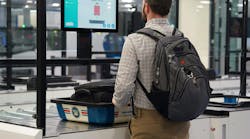Although it is been part of their legislative responsibility since the very beginning, it comes as a surprise to many people that TSA is the multi–modal "Transportation Security Administration", not the "Airport Security Administration." Until recently, it was apparently somewhat of a surprise to the agency as well. While they have always had theoretical jurisdiction over rail and subway trains, surface transportation such as trucks and buses, maritime transportation (it's not clear where they may overlap with Coast Guard), and pipelines (think of it as critical cargo); the VAST - capital letters, underscored – amount of their resources has been focused solely on the aviation infrastructure - screening passengers, employees and cargo, and locking down/ surveilling every corner of every commercial airport.
But recently, we have begun to see a significant uptick in TSA VIPR (Visible Intermodal Prevention and Response) teams popping up everywhere to conduct searches and screenings at train stations, ferry terminals, highway weigh stations, and even sporting events and rodeos. (Who thinks up acronyms like VIPR, anyhow? For the first 10 years, they have been virtually In-Visible).
Several thoughts come to mind:
First, in the context of TSA’s late blooming recent emphasis on RBS (Risk Based Security), what changed? Has aviation security become so good, so successful, that the bad guys are now looking at softer targets? Has the intelligence community seen a significant shift in threat to other modes to justify shifting scarce resources? (I am tempted, but shall not go the NSA route here).
Second, if TSA has had this responsibility since the Aviation and Transportation Security Act was enacted by the 107th U.S. Congress on November 19, 2001, where have they been for nearly 12 years? Equally curious, where has Congressional oversight been? Does the intelligence indicate that this imbalance among modal security is threat-appropriate, including the super-heavy emphasis on aviation, or is it a dereliction of duty to other modes?
Third, did the 107th Congress have the slightest clue what they were demanding in 2001: are the full-multi-modal security requirements suggested by ATSA attainable, sustainable, affordable, or, after 12 years of reflection, study, experience, and a lots of trial and plenty of error, effective? We had a very different view of the threat in those first several years. Numerous studies and Congressional reports have pointed out that TSA has discovered an awful lot of prohibited items, weapons, drugs, false documents, and just plain weird stuff, but nowhere among their accomplishments has been the identification or capture of the first actual terrorist.
Don't get me wrong – I'm not suggesting that TSA be shut down. Among other things, I suspect the no-fly list may have kept some unsavory people away, and indeed, the appearance of security, whether actually true or not, may continue to be a significant deterrence, driving the bad guys elsewhere – which I hasten to add, may or may not be venues within the TSA jurisdiction.
However, I do agree with many observers, including many in Congress, that TSA has become bloated with more than 15,000 bureaucrats ... an average of about 32.8 for each airport, not including the screeners, inspectors, BDOs, VIPRs, management, etc. – who have apparently lost sight of the goal. Sixty eight days after 9/11 was an appropriate and unusually quick time for Congress to mount this impressive experiment, and they get extra points for doing so in an almost total vacuum of relevant information. The real world of transportation security has evolved quite differently than we expected over the past 12 years; it's time for a total overhaul.


